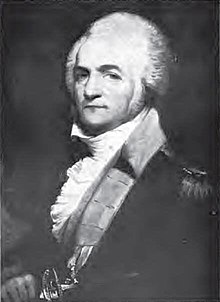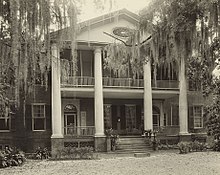Winthrop Sargent
| Winthrop Sargent | |
|---|---|
 | |
| Governor of Mississippi Territory | |
In office May 7, 1798 – May 25, 1801 | |
| Preceded by | Position established |
| Succeeded by | William C. C. Claiborne |
| Secretary of Northwest Territory | |
In office July 9, 1788 – May 31, 1798 | |
| Preceded by | Position established |
| Succeeded by | William Henry Harrison |
Adjutant General of the U. S. Army (Acting) | |
In office September 4, 1791 – November 4, 1791 | |
| Preceded by | John Pratt (Acting) |
| Succeeded by | Ebenezer Denny (Acting) |
| Personal details | |
| Born | (1753-05-01)May 1, 1753 Gloucester, Massachusetts |
| Died | June 3, 1820(1820-06-03) (aged 67) New Orleans, Louisiana |
| Political party | Federalist |
| Spouse(s) | Roewena Tupper (m. 1789; her death 1790) Mary McIntosh Williams |
| Relations | Judith Sargent Murray (sister) Benjamin Tupper (father-in-law) Paul Dudley Sargent (uncle) |
| Parents | Winthrop Sargent Judith Saunders |
| Alma mater | Harvard College |
Winthrop Sargent (May 1, 1753 – June 3, 1820) was a United States patriot, politician, and writer; and a member of the Federalist party.[1]
Contents
1 Early life
2 Career
2.1 Later life
3 Personal life
3.1 Legacy
4 References
5 External links
Early life
Sargent was born in Gloucester, Massachusetts on May 1, 1753. He was one of eight children born to Winthrop Sargent (1727–1793) and Judith Saunders. His elder sister was Judith Sargent Murray (1751–1820), an essayist, playwright, and poet.[2]
He was the grandson of Colonel Epes Sargent, one of the largest landholders in Gloucester.[3] Sargent was also the nephew of Daniel Sargent Sr. (1730–1806), a prominent merchant, Paul Dudley Sargent (1745–1828), who also served in the Continental Army, and John Sargent (1750–1824), a Loyalist during the Revolution.[4]
He graduated from Harvard College Class of 1771 before the Revolution. He spent some time at sea, as captain of a merchantman owned by his father.[5]
Career

~ Mississippi Territory ~~ Winthrop Sargent ~ Issue of 1948
He enlisted in Gridley's Regiment of Massachusetts Artillery on July 7, 1775 as a lieutenant, and later that year was promoted to captain lieutenant of Knox's Regiment, Continental Artillery, on December 10. He was with his guns at the siege of Boston, as well as the battles of Long Island, White Plains, Trenton, Brandywine, Germantown, and Monmouth. He was promoted to captain in the 3rd Continental Artillery on January 1, 1777, and brevetted major on August 25, 1783.[1]
In 1786, he helped to survey the Seven Ranges, the first lands laid out under the Land Ordinance of 1785. With inside knowledge of the area, he went on to form the Ohio Company of Associates, was an important shareholder in the Scioto Company, and as of 1787, secretary of the Ohio Company.[6]
Sargent was appointed by the Congress of the Confederation as the first Secretary of the Northwest Territory, a post second in importance only to the governor, Arthur St. Clair. He took up his post in 1788. Like St. Clair, Sargent would function in both civil and military capacities; he was wounded twice at the Battle of the Wabash, on November 4, 1791.[6] He also served in the Indian wars of 1794-5 and became adjutant general.[7] On August 15, 1796, he would, as Acting Governor, proclaim the establishment of Wayne County, the first American government in what is now Michigan.
President John Adams then appointed Sargent the first Governor of the Mississippi Territory, effective from May 7, 1798 to May 25, 1801.[8] His last entry as Northwest Territory's secretary was on May 31, 1798; he arrived at Natchez on August 6, but due to illness was unable to assume his post until August 16.[1]
Later life
In 1788, Sargent was elected a Fellow of the American Academy of Arts and Sciences.[9] He was also a member of the Philosophical Society and an original member of the Society of the Cincinnati as a delegate from Massachusetts, and published, with Benjamin B. Smith, Papers Relative to Certain American Antiquities (Philadelphia, 1796), and "Boston," a poem (Boston, 1803).[7]

Gloucester, Natchez, by Frances Benjamin Johnston, 1938. Originally known as Bellevue. Built by David Williams family, ca. 1800. Winthrop Sargent bought it from the Williams in 1808[10]
Being a Federalist, Sargent was dismissed from his position as territorial governor in 1801 by incoming president Thomas Jefferson. Sargent took up life in the private sector, developing his plantation Gloucester,[11] the earliest such establishment in Natchez. Sargent was elected a member of the American Antiquarian Society in 1813.[12]
Personal life
In 1789, he married Roewena Tupper (1766–1790), a daughter of Gen. Benjamin Tupper, at the settlement of Marietta in the first marriage ceremony held under the laws of the Northwest Territory.[13] After her death, he married Mary McIntosh Williams (1760–1823) shortly after moving to Natchez.[14] They were the parents of:[14]
- Caroline Augusta Sargent (1795–1844), who married Fielding Lewis Turner (1776–1843)
- William Fitz-Winthrop Sargent (b. 1799)
- George Washington Sargent (1802–1864), who married Margaret Isabella Jessie Percy (1802–1865).[14]
He died on June 3, 1820 in New Orleans.[15] His grandson was the writer Winthrop Sargent (1825–1870).
Legacy
Although there are at least two Sargent Townships (in Illinois and Nebraska) and one Sargent County, it is not known if these are named after Winthrop Sargent. However, a former township of the Northwest Territory's Wayne County was designated as Sargent Township or the District of Sargent; this apparently encompassed the settlements downriver from Detroit and at the River Raisin in what is now Monroe County, Michigan. This township apparently ceased to function after the organization of Michigan Territory, being replaced by the District of Erie.
A student dormitory at Ohio University (founded in 1804) in Athens, Ohio, is named Sargent Hall in his honor. This is the first university in the Northwest Territory and the first in Ohio.
References
^ abc Mississippi Dept of Archives and History (1905). The Mississippi Territorial Archives, 1798-18 ... Press of Brandon Print. Company. Retrieved 24 August 2017.
^ Sargent, Emma Worcester (1923). Epes Sargent of Gloucester and His Descendants. Houghton Mifflin. Retrieved 23 August 2017.
^ Copley, John Singleton (1760). "Epes Sargent". nga.gov. Retrieved 24 August 2017.
^ Sargent, Winthrop (1920). Colonel Paul Dudley Sargent. Philadelphia: Printed for Private Collection. Retrieved 23 August 2017.
^ Farrell, Betty (1993). Elite Families: Class and Power in Nineteenth-Century Boston. SUNY Press. ISBN 9780791415931. Retrieved 23 August 2017.
^ ab Biography of Winthrop Sargent on Ohio History Central retrieved 2/24/09
^ ab Wilson, James Grant; Fiske, John, eds. (1900). "Sargent, Paul Dudley". Appletons' Cyclopædia of American Biography. New York: D. Appleton.
Wilson, James Grant; Fiske, John, eds. (1900). "Sargent, Paul Dudley". Appletons' Cyclopædia of American Biography. New York: D. Appleton.
^ "Sword of Winthrop Sargent (1753-1820), First Governor of Northwest". www.artic.edu. The Art Institute of Chicago. Retrieved 24 August 2017.
^ "Book of Members, 1780–2010: Chapter S" (PDF). American Academy of Arts and Sciences. Retrieved July 28, 2014.
^ https://www.loc.gov/item/csas200907160/
^ [1]
^ American Antiquarian Society Members Directory
^ Zimmer, L: True Stories from Pioneer Valley, Broughton Foods Co., Marietta, Ohio (1987) p. 20.
^ abc "Winthrop Sargent Papers, 1771-1948". www.masshist.org. Massachusetts Historical Society. Retrieved 24 August 2017.
^ Skates, John Ray (1979). Mississippi: A Bicentennial History. New York City: W.W. Norton & Co. ISBN 0-393-05678-3.
| Political offices | ||
|---|---|---|
New title | Secretary of Northwest Territory July 9, 1788 – May 31, 1798 | Succeeded by William Henry Harrison |
Governor of Mississippi Territory May 7, 1798 – May 25, 1801 | Succeeded by William C. C. Claiborne | |
| Military offices | ||
| Preceded by John Pratt (acting) | Adjutant General of the U. S. Army September 4, 1791 – November 4, 1791 (acting) | Succeeded by Ebenezer Denny (acting) |
External links
- NNDB page
Winthrop Sargent at Ohio History Central.

 Clash Royale CLAN TAG#URR8PPP
Clash Royale CLAN TAG#URR8PPP


Comments
Post a Comment